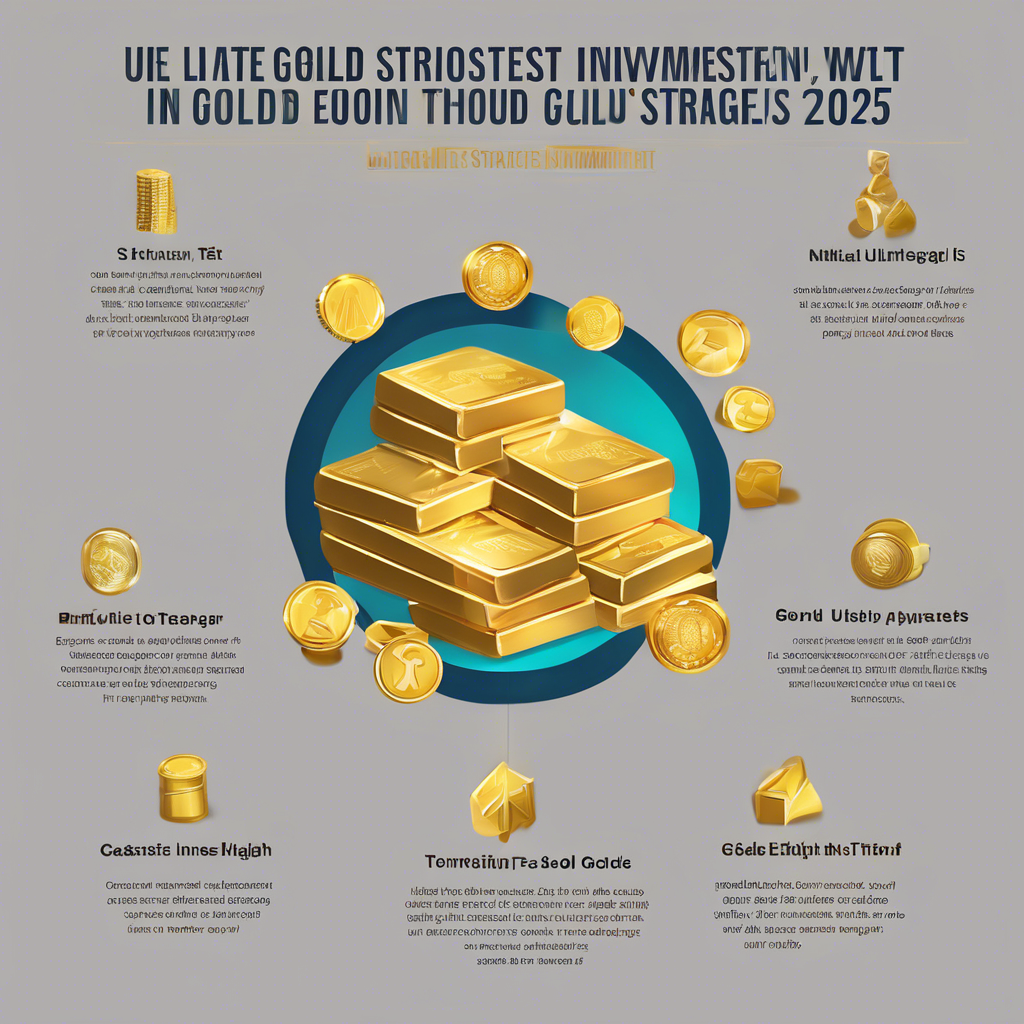Introduction to Gold Investment in 2025
In the rapidly evolving financial landscape, gold continues to be a beacon for investors seeking stability and growth. As we move into 2025, understanding gold investment strategies is crucial for both new and seasoned investors. In this ultimate guide, we will explore effective strategies designed to maximize your returns, mitigate risks, and navigate the complexities of the gold market.
Why Gold Remains a Preferred Investment
Gold has long been considered a safe haven asset, especially during periods of economic uncertainty. As inflation rises and geopolitical tensions simmer, many investors turn to gold as a hedge against market volatility. Additionally, gold’s intrinsic value and historical significance make it a timeless investment choice.
Investing in gold offers several advantages, including:
- Inflation Hedge: Gold often retains its purchasing power when inflation rises.
- Diversification: Including gold in your investment portfolio helps diversify risk.
- Liquidity: Gold is easily convertible into cash, providing flexibility in times of need.
Understanding Different Gold Investment Options
Before diving into specific strategies, it’s important to grasp the various forms of gold investments available:
1. Physical Gold: Bars and Coins
Investing in physical gold such as bars and coins allows you to own tangible assets. This method is favored by those who prioritize security and a direct connection to their investments.
2. Gold ETFs
Gold Exchange-Traded Funds (ETFs) offer a convenient way to invest in gold without the need for physical storage. These funds track the price of gold and can be traded like stocks, making them an attractive option for many investors.
3. Gold Stocks and Mining Companies
Investing in gold mining stocks provides exposure to gold prices while offering the potential for capital appreciation. However, this option comes with additional risks associated with the mining industry. For those interested, check out our guide on diversifying your portfolio with gold stocks.
Strategic Approaches to Gold Investment
As you consider your gold investment strategies for 2025, it’s essential to adopt a comprehensive approach. Here are some effective strategies to employ:
- Dollar-Cost Averaging: Invest a fixed amount in gold at regular intervals, regardless of the price. This strategy helps mitigate the impact of market volatility.
- Market Timing: While attempting to time the market can be risky, being aware of market trends and economic indicators can inform your investment decisions.
- Long-Term Holding: Investing in gold with a long-term perspective can yield significant returns, especially during periods of economic uncertainty.
For a deeper dive into the subject, explore our article on understanding gold prices and factors influencing market dynamics.
In conclusion, gold remains a vital component of a balanced investment portfolio. With a clear understanding of various investment options and strategies, you can navigate the gold market effectively in 2025. Stay tuned for more insights in our upcoming sections as we delve deeper into gold investment strategies and market predictions.
Evaluating Market Trends for Gold Investment
Understanding gold market trends is essential for successful investment. As we approach 2025, several factors are influencing gold prices, including economic indicators, geopolitical events, and central bank policies. Keeping an eye on these trends can help you make informed decisions about your investments.
1. Economic Indicators Affecting Gold Prices
Economic indicators such as inflation rates, employment statistics, and GDP growth significantly impact gold prices. For instance, rising inflation typically leads to increased demand for gold as a hedge. Stay updated on these indicators to align your gold investment strategy with market realities.
2. Geopolitical Events and Market Sentiment
Global events like political unrest, trade wars, and changes in government policies can drive investors toward gold. Understanding how these events correlate with market sentiment can help you anticipate price movements. For more insights on how to navigate these events, check out our analysis on 2025 gold market analysis.
Diversifying with Gold Mutual Funds
For those looking to diversify their portfolios, gold mutual funds offer an excellent avenue. These funds pool money from multiple investors to buy shares of gold-related assets, providing an easy way to gain exposure to the gold market without having to manage physical assets.
Benefits of Gold Mutual Funds
Investing in gold mutual funds can yield several advantages, such as:
- Professional Management: Your investment is managed by professionals who analyze market conditions and make informed decisions.
- Liquidity: Gold mutual funds are generally easy to buy and sell, providing flexibility for investors.
- Diversification: By investing in a fund, you gain exposure to a variety of gold investments, spreading risk across different assets.
To explore the best options for your portfolio, check out our guide on top gold mutual funds.
Understanding Gold Supply and Demand Dynamics
The supply and demand dynamics of gold play a crucial role in determining its price. Supply can be affected by mining production, recycling rates, and central bank policies, while demand stems from jewelry, technology, and investment sectors. Keeping abreast of these factors will enhance your ability to make wise investment choices.
1. Mining Production and Its Impact
Changes in mining output can directly affect gold supply. When production increases, prices may stabilize or decline. Conversely, a decrease in production can lead to higher prices. Understanding these trends is essential for anticipating market movements. For a closer look at the mining sector, refer to our post on investing in gold mining stocks.
2. The Role of Central Banks
Central banks hold significant gold reserves, and their buying or selling activities can influence market prices. Monitoring central bank actions can provide valuable insights into future price movements. For more information on how these actions affect the market, read our article on central bank actions and gold demand trends.
Conclusion: The Future of Gold Investments
In conclusion, as you prepare for gold investment in 2025, consider the various aspects discussed above. By evaluating market trends, diversifying your portfolio with gold mutual funds, and understanding supply and demand dynamics, you can develop a robust investment strategy. Stay informed and ready to adapt to the ever-changing gold market to maximize your returns.
Effective Strategies for Trading Gold in Volatile Markets
Trading gold can be profitable, especially when employing effective trading strategies. The key is to stay informed about market fluctuations and economic conditions. Timing your trades can increase your returns significantly, especially during periods of volatility. For additional insights into trading strategies, consider exploring our guide on mastering gold trading techniques.
1. Understanding Market Conditions
Before entering the gold market, it’s crucial to understand the current conditions. This includes analyzing trends, news reports, and economic indicators. Utilize resources that provide in-depth gold price analysis to make well-informed decisions. By monitoring the market closely, you can identify favorable trading opportunities.
2. Setting Up a Trading Plan
Having a solid trading plan is essential for success in the gold market. This plan should include your investment goals, risk tolerance, and strategies for entering and exiting trades. A well-structured plan can help you stay disciplined and avoid emotional decision-making. To improve your trading skills, check out our post on successful gold trading tactics.
Diversifying Your Gold Investment Portfolio
Diversification is a fundamental principle of investing. By spreading your investments across various assets, you can minimize risk and maximize returns. In the context of gold, consider incorporating different forms such as physical gold, gold stocks, and ETFs.
1. Investing in Physical Gold
Physical gold, such as bullion and coins, provides a tangible asset that can act as a hedge against inflation. If you’re new to buying physical gold, our comprehensive guide on buying gold coins can help you navigate the process effectively.
2. Exploring Gold ETFs and Mutual Funds
For those looking for a more liquid investment option, gold ETFs and mutual funds are excellent choices. These investment vehicles offer exposure to gold without the need to manage physical assets. To learn more about these options, read our article on investing in gold ETFs.
Analyzing Gold Price Dynamics: Factors at Play
Understanding the factors that influence gold prices is vital for making informed investment decisions. Key elements include supply and demand dynamics, inflation rates, and geopolitical events.
1. Supply and Demand Fundamentals
The relationship between supply and demand plays a significant role in determining gold prices. When demand exceeds supply, prices tend to rise. Conversely, an oversupply can lead to price declines. Staying informed about mining production and recycling rates can help you anticipate market movements. For a deeper dive into these dynamics, explore our analysis on supply and demand trends.
2. The Impact of Global Events
Geopolitical events, such as conflicts or changes in government policies, can create uncertainty in the markets, leading investors to seek safe-haven assets like gold. Keeping abreast of global news can provide valuable insights into potential price fluctuations. For further insights on how these events affect gold prices, refer to our post on gold price influencers.
Conclusion: Strengthening Your Gold Investment Strategy
As you refine your gold investment strategy, remember to implement effective trading strategies, diversify your portfolio, and analyze market dynamics. By staying informed and adaptable, you can navigate the complexities of the gold market and maximize your investment returns. With the right approach, gold can serve as a reliable and profitable asset in your investment portfolio.
Understanding Gold Investment Strategies for 2025
As we look ahead to 2025, refining your gold investment strategies becomes increasingly important. The dynamics of the gold market are influenced by a variety of factors, including economic conditions, geopolitical tensions, and changing investment trends. By understanding these elements, you can make informed decisions and enhance your portfolio. To explore more about the current market environment, check out our comprehensive gold market analysis.
1. Long-Term vs. Short-Term Investments
When investing in gold, it’s essential to determine whether you are aiming for long-term or short-term gains. Long-term investments in gold can provide stability and act as a hedge against inflation. Conversely, short-term trading may capitalize on market volatility and price changes. For those considering a long-term strategy, our article on long-term benefits of holding gold offers valuable insights.
2. Safe-Haven Asset Consideration
Gold is often viewed as a safe-haven asset, particularly during times of economic uncertainty. Understanding when to leverage this aspect of gold can significantly impact your investment strategy. For more information on gold as a hedge, refer to our post on gold as a reliable investment hedge.
Implementing Risk Management Techniques
Risk management is crucial in any investment strategy, particularly in the volatile gold market. Implementing effective risk management techniques can help protect your investments and minimize potential losses.
1. Setting Stop-Loss Orders
Using stop-loss orders can be an effective way to manage risk in your gold trading. This strategy allows you to set a price point at which your asset will be sold to minimize losses. For more on effective trading techniques, check our guide on effective strategies for trading gold.
2. Diversifying Across Gold Investments
Diversification within your gold investments is another key risk management strategy. Consider adding a mix of physical gold, gold mining stocks, and ETFs to your portfolio. This approach can help cushion against market volatility. For tips on creating a balanced gold investment portfolio, see our post on best gold investments for beginners.
The Role of Technology in Gold Trading
As we move towards 2025, technology will continue to shape the gold trading landscape. From online trading platforms to advanced analytical tools, leveraging technology can enhance your trading strategies.
1. Utilizing Trading Platforms
Online trading platforms provide real-time data and analytics, enabling investors to make informed decisions quickly. Familiarizing yourself with these tools can improve your ability to react to market changes. For guidance on navigating gold trading platforms, explore our article on navigating gold trading platforms.
2. Accessing Market Research Tools
Market research tools can offer insights into market trends, price movements, and investment opportunities. Staying updated with the latest research can help refine your gold investment strategies. For comprehensive market analysis, refer to our post on understanding gold price dynamics.
Conclusion: Mastering Your Gold Investment Approach
As we approach 2025, mastering your gold investment strategies is vital to achieving your financial goals. By understanding market dynamics, implementing risk management techniques, and leveraging technology, you can navigate the complexities of gold trading effectively. Remember, investing in gold is not just about immediate returns; it’s about creating a resilient portfolio that can withstand market fluctuations. For further insights into building a robust gold investment strategy, consider our comprehensive guide on gold investment strategies.
Frequently Asked Questions About Gold Investment
1. What are the benefits of investing in gold?
Investing in gold offers numerous benefits, including portfolio diversification, protection against inflation, and serving as a safe-haven asset during economic uncertainty. Gold has historically maintained its value, making it a reliable investment option.
2. How much gold should I have in my investment portfolio?
The amount of gold to include in your portfolio depends on your financial goals and risk tolerance. Financial advisors typically recommend allocating 5-10% of your total investment portfolio to gold to provide a hedge against market volatility.
3. What are the different ways to invest in gold?
There are several ways to invest in gold, including physical gold (bullion, coins), gold mining stocks, gold exchange-traded funds (ETFs), and gold mutual funds. Each method has its unique benefits and risks, so it’s essential to consider what aligns best with your investment strategy.
4. Is gold a good investment during economic downturns?
Yes, gold is often considered a good investment during economic downturns. Its value tends to remain stable or even increase when other assets decline, making it a popular choice for investors seeking to protect their wealth.
5. How do I choose the right gold investment strategy?
Choosing the right gold investment strategy involves assessing your investment goals, time horizon, and risk tolerance. It’s also beneficial to stay informed about market trends and economic conditions that may influence gold prices. Consulting with a financial advisor can provide personalized guidance.
6. What factors influence the price of gold?
The price of gold is influenced by various factors, including supply and demand dynamics, currency fluctuations (especially the US dollar), geopolitical tensions, and economic indicators such as inflation rates and interest rates. Understanding these factors can help investors make informed decisions.
7. How can I store physical gold safely?
Storing physical gold safely can be done through secure vaults, safety deposit boxes at banks, or home safes. Each option has its advantages and risks, so it’s essential to evaluate your security needs and insurance coverage before deciding.
8. Are gold ETFs a good investment?
Gold ETFs can be a good investment for those looking to gain exposure to gold without the need for physical storage. They offer liquidity, ease of trading, and typically lower management fees compared to mutual funds.
9. What is the impact of inflation on gold prices?
Inflation generally has a positive impact on gold prices, as investors often turn to gold as a hedge against rising prices. When inflation increases, the purchasing power of currency decreases, making gold a more attractive investment.
10. How do I sell my gold investments?
Selling gold investments can be done through various channels, including gold dealers, online platforms, or auctions. It’s important to research current market prices and choose a reputable seller to ensure you receive a fair value for your gold.
Conclusion: Navigating Gold Investment Strategies for the Future
As we approach 2025, mastering your gold investment strategies is crucial for achieving your financial goals. By understanding market dynamics, implementing effective risk management techniques, and leveraging technological advancements, you can successfully navigate the complexities of gold trading. Investing in gold is not merely about immediate returns; it’s also about building a resilient portfolio that can endure market fluctuations. With the insights provided in this guide, you are now better equipped to make informed decisions regarding your gold investments. For further exploration of gold investment strategies, consider our comprehensive guide on gold investment strategies.










